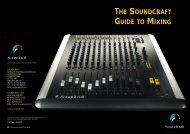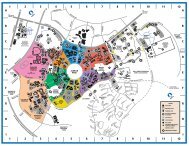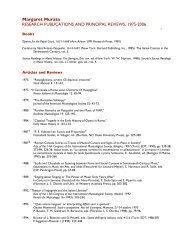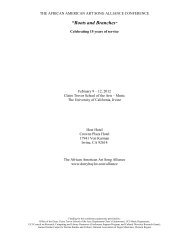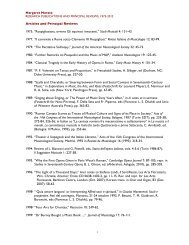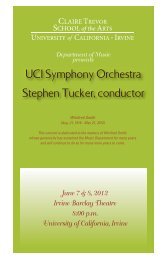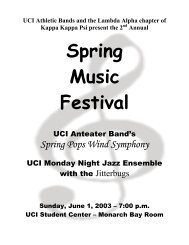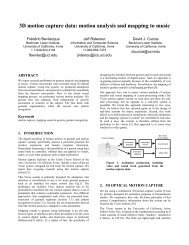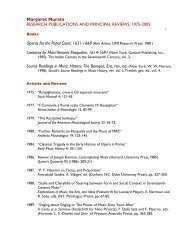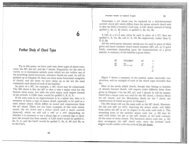What the GRM brought to music: from musique concre`te to ...
What the GRM brought to music: from musique concre`te to ...
What the GRM brought to music: from musique concre`te to ...
Create successful ePaper yourself
Turn your PDF publications into a flip-book with our unique Google optimized e-Paper software.
202 Marc Battierattitude <strong>to</strong>wards composition. Managing flows, makingimages emerge <strong>from</strong> sound – all that evolved <strong>from</strong> <strong>the</strong>end of <strong>the</strong> 1960s, but it is Bayle who translated <strong>the</strong>compositional option in<strong>to</strong> a conceptual formation.It was during <strong>the</strong>se decisive years that <strong>the</strong> compositionaltendency, designated by <strong>the</strong> term ‘acousmatic’became stronger; <strong>the</strong> term approved by Schaeffer at <strong>the</strong>end of <strong>the</strong> 1950s (and which afterwards passed in<strong>to</strong>general use) was adapted <strong>to</strong> describe <strong>music</strong> recordedon<strong>to</strong> sound media. This exists without any visualinformation for <strong>the</strong> public. According <strong>to</strong> his own<strong>the</strong>ory, <strong>the</strong> effort of causal recognition collides with aconstant erasure organised by <strong>the</strong> crea<strong>to</strong>r. When Baylerecovered <strong>the</strong> term in <strong>the</strong> middle of <strong>the</strong> 1970s, hecommented on <strong>the</strong> perpetuation of <strong>the</strong> model. One cansee by this action <strong>the</strong> choice between <strong>music</strong> recorded ona given medium and o<strong>the</strong>r forms of <strong>music</strong>al presentation;for example, mixed <strong>music</strong> allying instruments andan electroacoustic constituent without distinction ei<strong>the</strong>rthrough a medium or live, direct, which continuallyexpanded elsewhere during this period. Bayle promoted<strong>the</strong> term acousmatic above all <strong>to</strong> make visible <strong>the</strong> new<strong>the</strong>oretical status of <strong>the</strong> <strong>music</strong>al object. Schaefferquickly realised this, when he declared <strong>to</strong> Bayle thatuntil <strong>the</strong>n <strong>the</strong> <strong>music</strong>al object gave life <strong>to</strong> time, but afterBayle had fur<strong>the</strong>r evolved Schaefferian ideas, it was timethat gave life <strong>to</strong> <strong>the</strong> <strong>music</strong>al object.REFERENCESBayle, François. 1993. Musique acousmatique. Propositions …positions. Paris: Buchet-Chastel and Institut national de lacommunication audiovisuelle.Bayle, François. 2003. L’image de son. Technique de monécoute/Klangbilder. Technik meines Hörens. Münster: LitVerlag, Bilingual edition.Chion, Michel. 1983. Guide des objets sonores. PierreSchaeffer et la recherche <strong>music</strong>ale. Paris: INA/BuchetChastel.Chion, Michel. 1998. Le Son. Paris: Nathan.Dufourt, Hugues. 1999. ‘Pierre Schaeffer: le son commephénomène de civilisation’, in Ouïr, entendre, écouter,comprendre après Schaeffer. Paris: Buchet/Chastel, pp.69–82.Gayou, Évelyne. 2006. ‘Le <strong>GRM</strong>, Groupe de recherches<strong>music</strong>ales. Des racines de la <strong>musique</strong> concrète àl’électroacoustique des années 2000. His<strong>to</strong>ire, oeuvres,concepts, outils: une synthèse’, doc<strong>to</strong>ral <strong>the</strong>sis supervisedby J.-Y. Bosseur, Université Paris-Sorbonne.Risset, Jean-Claude. 1999. ‘Pierre Schaeffer: recherche etcréation <strong>music</strong>ales et radiophoniques’, in Ouïr, entendre,écouter, comprendre aprèsSchaeffer. Paris: Buchet/Chastel,pp. 69–82.Schaeffer, Pierre. 1952. A la recherche d’une <strong>musique</strong> concrete.Paris: Seuil.Schaeffer, Pierre. 1966. Traité des objets <strong>music</strong>aux. Essaiinterdisciplines. Paris: Seuil.Teruggi, Daniel. 1998. ‘Le système SYTER. Son his<strong>to</strong>ire, sesdéveloppements, sa production <strong>music</strong>ale, ses implicationsdans le langage électroacoustique d’aujourd’hui’, doc<strong>to</strong>ral<strong>the</strong>sis, Université Paris 8.Thomas, Jean-Chris<strong>to</strong>phe (ed.). 1999. Ouïr, entendre, écouter,comprendre après Schaeffer. Paris: Buchet/Chastel.Thomas, Jean-Chris<strong>to</strong>phe, Philippe, Mion, and Jean-Jacques, Nattiez. 1982. L’envers d’une oeuvre. Denatura sonorum de Bernard Parmegiani. Paris: Buchet/Chastel and Institut national de la communicationaudivisuelle.



